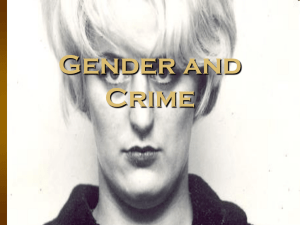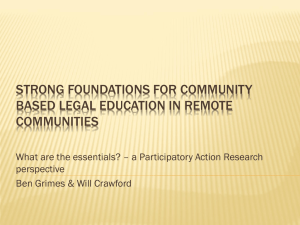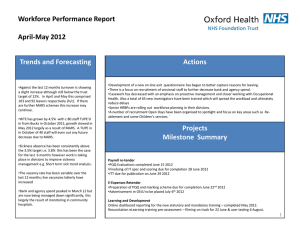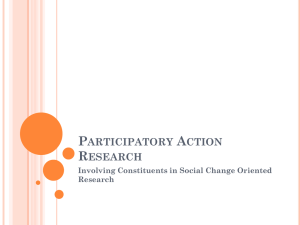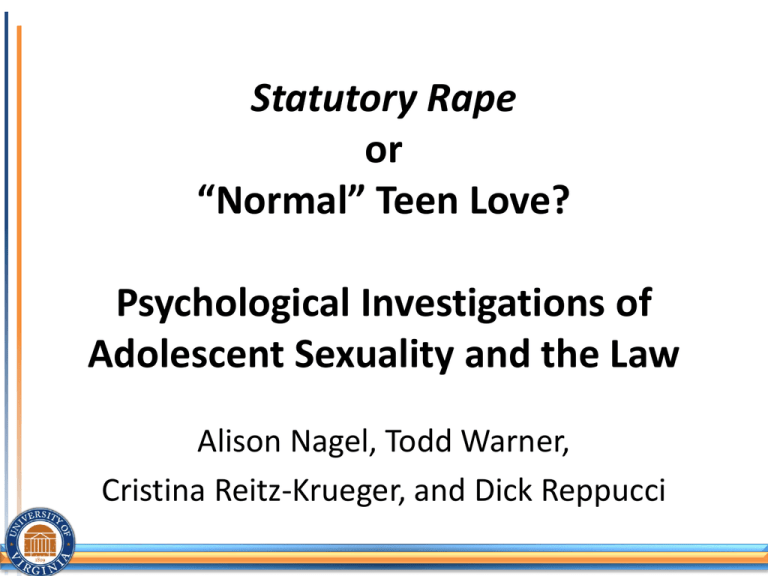
Statutory Rape
or
“Normal” Teen Love?
Psychological Investigations of
Adolescent Sexuality and the Law
Alison Nagel, Todd Warner,
Cristina Reitz-Krueger, and Dick Reppucci
Outline
• Statutory Rape Laws- Why We Care
– Study description and methodology
• Knowledge and Opinions of the Laws
– What do people know and think about
statutory laws?
• Sex Offender Registry for Statutory Crimes
– Opinions of registration for teens
• Future directions and feedback
Adolescent Sexuality –
Why is it relevant?
• The majority of adolescents have had sexual
intercourse by the age of 18
– 60 – 70% (Carver, Joyner, & Udry, 2004; Grunbaum et al.,
2004)
• Empirical and anecdotal evidence suggests
that it is not uncommon for teenage girls to
date slightly older boys (Leitenberg & Saltzman, 2003)
Statutory Rape Laws
• Presumably, statutory rape laws are intended
to protect minors from sexual exploitation
perpetrated by adults.
• While every state has statutory rape laws, the
variation among states suggests no national
consensus for the age at which adolescents’
can competently consent to sexual activity.
Statutory Laws
• For Example:
– A 19 year old male and 15 year old female
have sexual intercourse: The maximum
sentence could be…
• Georgia = 20 years, convicted of Statutory Rape
• Virginia = 1 year, convicted of Causing or
encouraging acts rendering children delinquent
• Maine = Legal
Statutory Rape Laws
• “Romeo and Juliet” laws: less punitive
sentencing for partners within certain age
gaps
• Despite these laws, teens and young adults
can still be prosecuted, serve jail time, and be
required to register as a sex offender for
certain violations.
Statutory Rape Cases Create Stir
Genarlow Wilson
-17 year old student, was videotaped
receiving oral sex from 15 year old female.
• Was sentenced to 11 years in prison for aggravated child
molestation and required to register as a sex offender for life.
• Georgia Supreme Court eventually ruled 4-3 that
Wilson’s sentence constituted cruel and unusual punishment
(Humphrey v. Wilson, 2007 and Wilson v. The State of Georgia, 2007).
Robert DiPiazza
• 18-year old student and almost 15-year old girlfriend,
teacher saw picture of him touching her in a sexual
way, reported to the authorities.
• Was required to register as a sex offender for 25 years.
• Now, is married to the “victim” from the case.
• Michigan appeals court overturned the decision and
required him to be removed from the registry.
Youth Nex Grant Origins
• Oudekerk, B., Farr, R., & Reppucci, N.D., (2010). Is it love or sexual
abuse? Young adults perceptions of statutory relationships (under
review)
– (N = 180) young adults’ assessments of a statutory rape case
– Manipulated the age difference between partners: 2, 4, or 6 yrs
– Asked about knowledge and perceptions of current laws
regarding statutory rape in VA.
• Results
– Found that participants generally disagreed that any
relationship where the younger partner is 15 should be a crimeBUT as age gap increased older partners were judged more
harshly.
– Importantly, found that young adults were poor at accurately
identifying illegal statutory relationships.
Youth Nex Grant Origins
• Patrick Tolan and the Center for Effective
Youth Development…to the rescue!
• Setting the stage for a larger grant.
• Three part study:
– Adolescent Focus Groups
– Young Adults Survey
– Parents Survey
Part 1: Adolescent Focus Groups
• Focus groups with teens and young adults
– Separated by age and gender:
• 13-14 years old
• 15-17 years old
• 18 years and older
• Qualitative data on how boys and girls of varying
ages conceptualize sexual decision making
• At what age do teens’ answers mirror those of
adults?
Parts 2 and 3: An Epic Survey
Young Adults Survey:
Parents Survey:
• Participants are parents of
• Participants are between 18
teens ages 13-17
– 24 years old
• Why? Young adults under the • Why? “In many cases,
[statutory rape laws] are
age of 24 are the most likely
enforced largely by how
perpetrators of statutory
angry the parents of the
rape crimes (Troup-Leasure &
younger party are,”
Snyder, 2005)
(Gramlich, 2007).
• 76% of male offenders and
55% of female offenders are
24 or younger.
Method
• Participants for both online surveys recruited from
Mechanical Turk (www.mturk.com)
• Surveys assess participants’:
• Knowledge of the statutory rape laws in their
state
• Opinions on what the laws should be
• Perceptions of fairness regarding possible
penalties
• Sources of knowledge about laws
• Opinions of sex offender registry
Method
Young Adults:
Parents:
• 11 survey conditions
• 12 survey conditions
• 5 vignettes that correspond
• 11 vignettes varying age and
to the Young Adult
conditions, representing
age differences between
major levels of crime in
older and younger partner
Virginia
• Represent 5 of Virginia’s
• Asked to pretend they are
statutory rape laws the parent of either the
additional conditions come
older or younger partnerwould they report the
from varying gender and
relationship, or try to
exact ages of older and
convince their ‘child’ to end
younger partner
the relationship?
• 1 condition with no vignette
• 1 condition with no
vignette
Demographics
Young Adult
•
•
•
•
N = 355
50 % Female
M age = 21.23 SD = 1.98
Ethnicity
– 77% Caucasian
• Education = Some college
• 81% Heterosexual
• 50% single; 36% in rx not
married
• HH income = $30, 00040,000
Parents
• N = 305
• 64% Female (Mothers)
• M age = 41.53 SD = 7.67
• Ethnicity
– 78% Caucasian
• Education = 2 yr college deg
• 92% Heterosexual
• 67% Married; 13%
Divorced/Widowed
• HH income = $30,00040,000
Statutory Laws
• What are the laws in your state?
• Potentially, very
confusing!
Knowledge
• So what DO young adults and Parents know
about statutory rape laws?
• 2009: Complied list of statutory laws for each
state
Knowledge
Older Partner Age Younger Partner
and Gender
Age and Gender
Crime Committed
Maximum Punishment
16 – boy
13 – girl
Class 6 felony- Carnal knowledge of a
child 13 or 14 when older partner is
minor and 3 or more years older
5 years in jail; 1 year in jail
and $2,500 fine
16 – boy
14 – girl
Class 4 misdemeanor- carnal knowledge
of a child where the younger partner is
13 or 14 and the older partner is a minor
and less than 3 years older
Fine of not more than $250
18 – boy
14 – girl
20 – boy
16 – girl
24 – boy
14 – girl
Class 4 felony- carnal knowledge of a 10 years in jail and $100,000
child 13 or 14 when older partner is
fine
more than 4 years older
Class 1 misdemeanor- delinquency of a 1 year in jail and $2,500 fine
minor
Class 4 felony- carnal knowledge of a 10 years in jail and $100,000
child 13 or 14 when older partner is
fine
more than 4 years older
Knowledge
Dating Scenarios
A ___ year old boy and his ___ year old girlfriend have sex. Both of
them agreed and were willing. Neither was under the influence of
drugs or alcohol at the time.
1) 16 yr old – 13 yr old
2) 16 yr old – 14 yr old
3) 18 yr old – 14 yr old
4) 20 yr old – 16 yr old
5) 24 yr old – 14 yr old
Knowledge
• According to the law in your state, is this
relationship a crime?
– Yes
– No
– I don’t Know
Knowledge
Dating Scenario
1) 16 yr – 13 yr old
(n=80)
2) 16 yr – 14 yr old
(n=98)
3) 18 yr – 14 yr old
(n=109)
4) 20 yr – 16 yr old
(n=92)
5) 24 yr – 14 yr old
(n=76)
Correct
Incorrect
DK
YA
Par
YA
Par
YA
Par
27%
37%
40%
24%
33%
39%
41%
52%
21%
26%
38%
22%
74%
74%
3%
3%
23%
23%
44%
55%
25%
23%
31%
21%
79%
87%
0%
1%
21%
12%
Knowledge
Dating Scenario
1) 16 yr – 13 yr old
(n=80)
2) 16 yr – 14 yr old
(n=98)
3) 18 yr – 14 yr old
(n=109)
4) 20 yr – 16 yr old
(n=92)
5) 24 yr – 14 yr old
(n=76)
Correct
Incorrect
DK
YA
Par
YA
Par
YA
Par
27%
37%
40%
24%
33%
39%
41%
52%
21%
26%
38%
22%
74%
74%
3%
3%
23%
23%
44%
55%
25%
23%
31%
21%
79%
87%
0%
1%
21%
12%
Knowledge
Dating Scenario
1) 16 yr – 13 yr old
(n=80)
2) 16 yr – 14 yr old
(n=98)
3) 18 yr – 14 yr old
(n=109)
4) 20 yr – 16 yr old
(n=92)
5) 24 yr – 14 yr old
(n=76)
Correct
Incorrect
DK
YA
Par
YA
Par
YA
Par
27%
37%
40%
24%
33%
39%
41%
52%
21%
26%
38%
22%
74%
74%
3%
3%
23%
23%
44%
55%
25%
23%
31%
21%
79%
87%
0%
1%
21%
12%
Knowledge
Dating Scenario
1) 16 yr – 13 yr old
(n=80)
2) 16 yr – 14 yr old
(n=98)
3) 18 yr – 14 yr old
(n=109)
4) 20 yr – 16 yr old
(n=92)
5) 24 yr – 14 yr old
(n=76)
Correct
Incorrect
DK
YA
Par
YA
Par
YA
Par
27%
37%
40%
24%
33%
39%
41%
52%
21%
26%
38%
22%
74%
74%
3%
3%
23%
23%
44%
55%
25%
23%
31%
21%
79%
87%
0%
1%
21%
12%
Knowledge for groups
• No difference between parents and
young adults knowledge accuracy.
– χ2’s > .26
• No gender differences (χ2’s > .15)
– Parents: Fathers v. Mothers (ns)
– YA: Male v. Female (ns)
Conclusion
• Knowledge of Statutory Rape Laws:
– Parents and young adults have relatively
inaccurate understanding of statutory rape laws.
Public Opinion
In your opinion,
should this
relationship be a
crime?
% Probably –
Definitely
Should NOT
% Maybe
% Probably –
Definitely
Should
YA
Par
YA
Par
YA
Par
1) 16 yr – 13 yr old
60%
49%
21%
20%
19%
31%
2) 16 yr – 14 yr old
88%
63%
12%
26%
0%
11%
3) 18 yr – 14 yr old
30%
32%
33%
21%
36%
46%
4) 20 yr – 16 yr old
47%
34%
34%
32%
19%
34%
5) 24 yr – 14 yr old
17%
14%
4%
21%
75%
65%
Public Opinion
In your opinion,
should this
relationship be a
crime?
% Probably –
Definitely
Should NOT
% Maybe
% Probably –
Definitely
Should
YA
Par
YA
Par
YA
Par
1) 16 yr – 13 yr old
60%
49%
21%
20%
19%
31%
2) 16 yr – 14 yr old
88%
63%
12%
26%
0%
11%
3) 18 yr – 14 yr old
30%
32%
33%
21%
36%
46%
4) 20 yr – 16 yr old
47%
34%
34%
32%
19%
34%
5) 24 yr – 14 yr old
17%
14%
4%
21%
75%
65%
Public Opinion
In your opinion,
should this
relationship be a
crime?
% Probably –
Definitely
Should NOT
% Maybe
% Probably –
Definitely
Should
YA
Par
YA
Par
YA
Par
1) 16 yr – 13 yr old
60%
49%
21%
20%
19%
31%
2) 16 yr – 14 yr old
88%
63%
12%
26%
0%
11%
3) 18 yr – 14 yr old
30%
32%
33%
21%
36%
46%
4) 20 yr – 16 yr old
47%
34%
34%
32%
19%
34%
5) 24 yr – 14 yr old
17%
14%
4%
21%
75%
65%
Public Opinion
In your opinion,
should this
relationship be a
crime?
% Probably –
Definitely
Should NOT
% Maybe
% Probably –
Definitely
Should
YA
Par
YA
Par
YA
Par
1) 16 yr – 13 yr old
60%
49%
21%
20%
19%
31%
2) 16 yr – 14 yr old
88%
63%
12%
26%
0%
11%
3) 18 yr – 14 yr old
30%
32%
33%
21%
36%
46%
4) 20 yr – 16 yr old
47%
34%
34%
32%
19%
34%
5) 24 yr – 14 yr old
17%
14%
4%
21%
75%
65%
Public Opinion
In your opinion,
should this
relationship be a
crime?
% Probably –
Definitely
Should NOT
% Maybe
% Probably –
Definitely
Should
YA
Par
YA
Par
YA
Par
1) 16 yr – 13 yr old
60%
49%
21%
20%
19%
31%
2) 16 yr – 14 yr old
88%
63%
12%
26%
0%
11%
3) 18 yr – 14 yr old
30%
32%
33%
21%
36%
46%
4) 20 yr – 16 yr old
47%
34%
34%
32%
19%
34%
5) 24 yr – 14 yr old
17%
14%
4%
21%
75%
65%
Perceptions of groups
• Parents more likely to think should be a crime
compared to young adults (all other ns).
– 20 yr – 16 yr: p = .038*
– 16 yr – 14 yr: p = .004**
• Female young adults more likely think should
be a crime (all other ns).
– 20 yr – 16 yr: p = .004**
• Interestingly, no difference in opinions
between mothers and fathers (all ns).
Conclusions
• Perceptions:
– Majority of parents and young adults report
relationship b/t 2 minors should NOT be a crime.
– In these instances where it IS a crime, does not
seem to match public opinion (for both YA’s and
parents).
Take home message
• Overall, young adults’ and parents’ knowledge
and opinions quite similar.
• Specifically for knowledge, this can be quite
problematic considering the legal
consequences of engaging in these
relationships
– Spend time in jail
– Possibly labeled a felon for life
– Could have to register as a sex offender for life…
Perceptions of Sex Offender Registry
in the Context of Consensual Sex
Between Teens
What is the Sex Offender Registry?
• 1994 Jacob Wetterling Act; 1996 Megan’s Law; 2006
SORNA/Adam Walsh Act
• Prevention not punishment
– Deter offenders and would-be offenders
– Protect public by making them aware of sex offenders
– Allow law enforcement to monitor known sex offenders
• Various means of notification
• Juveniles required to register in 28 states (as
of 1999)
The Public is in Favor
• 92% support the use of S.O. registries
• Majority think they’re effective (54 – 90%)
• 78% think they’re fair
• 80% think they’re constitutional and not in
violation of 8th or 5th amendments
• 75% don’t think they violate rights to privacy
(37% say sex offenders have no rights)
(Brannon et al., 2007; Schiavone et al., 2009; Mears et al., 2008)
Still in Favor?
• Limits where you can live and
work
•Those on the registry report
receiving threats or actual abuse
against self or property
•Is it a developmentally
appropriate response for
juveniles?
According to the law in at least one state, if a 19-year-old
and a 14-year-old engage in a sexual relationship – even in
situations where both partners were willing and agree to it
- the older partner can be placed on a sex offender
registry. This means that the older partner will appear as a
sex offender on a registry accessible by anyone.
• In this particular instance, does the SOR do what it is
supposed to do?
• Is it fair for the older partner?
• Does the older partner represent the type of sex
offender we should really worry about?
% Who Somewhat –
Strongly Disagree
Mean Response
(SD)
57.1%
3.18 (1.55)
The community will be safer if the older
partner is on the SOR.
65.4%
2.78 (1.44)
Placing the older partner on the SOR will
help protect the younger partner.
72.3%
2.62 (1.42)
Placing the older partner on the SOR will
deter other adolescents from engaging in
this kind of behavior.
46.6%
3.37 (1.64)
Placing the older partner on the SOR will
help police keep the community safer by
allowing them to monitor him/her.
47.1%
3.35 ( 1.51)
Overall SOR Efficacy Score (alpha = .85)
-
3.06 (1.17)
Efficacy Statement
Being placed on the SOR will prevent the
older partner from committing a similar
crime in the future.
1 – Strongly Disagree, 2 – Disagree, 3 – Somewhat Disagree, 4 – Somewhat Agree, 5 – Agree, 6 – Strongly Agree
Statement
Placing the older partner on the SOR
could negatively affect the younger
partner.
The older partner will be unfairly
disadvantaged if placed on the SOR.
Compared to other people on the SOR,
we do not need to be as worried about
the older partner in this scenario.
% Somewhat Agree –
Strongly Agree
Mean (SD)
69.9%
4.11(1.49)
74.3%
4.38 (1.54)
71.3%
4.37 (1.54)
Statement
% No
Should the older partner be required to
register as a sex offender?
61%
Should the older partner be required to
register for life?
90.3%
1 – Strongly Disagree, 2 – Disagree, 3 – Somewhat Disagree, 4 – Somewhat Agree, 5 – Agree, 6 – Strongly Agree
What Correlates to Opinions of SOR?
• Parental status and gender do not.
• Nor does income or education
• For YA, neither does time spent around
adolescents or having been in a relationship
with someone under 18 when you were over
18
What Correlates with Opinions of SOR?
Question
Religiosity
Political
Affiliation
Relationship <15
when > 18
Overall Effectiveness of SOR
.135**
n.s.
n.s.
Fairness to older partner
-.099*
.147**
n.s.
Should we worry about older
partner compared to other sex
offenders?
-.112**
.136**
.160*
(YA only)
Should he have to register?
-.172*
.082*
n.s.
Should have to register for
life?
n.s.
.092*
n.s.
Discussion
• There isn’t overwhelming support for the SOR
in all cases.
• It’s likely that people may find the SOR even
less favorable when the older partner is a
minor.
• Given the significant implications of being
placed on an SOR, perhaps this isn’t a onesize-fits-all solution, especially where youth
are involved.
Future Directions
In our study
• What factors lead parents to report statutory
relationships?
• At what age does the public feel adolescents are
old enough to consent to sex?
• Prevalence of statutory relationships.
• Where do people get their information on
statutory relationships?
• Do parents talk to their children about the legal
(& other) consequences of stat. relationships?
Future Directions
In future studies
• What factors lead prosecutors to go forward with
these cases?
• At what age are adolescents actually competent
enough to consent to sex?
• What are effective ways to educate the public, and
especially youth, about statutory rape laws?
• What are the real experiences of juveniles and
young adults placed on the sex offender registry?
• What are the experiences of the “victims” in these
cases?
Thank You!
• Youth-Nex - The U.Va. Center to Promote Effective
Youth Development
• Other members of the Reppucci Lab: Dick Reppucci, Barbara
Oudekerk, Siny Tsang, Tammi Walker, Lucy Guarnera, Kristen Jenkins,
Mark Manning, Lauren George, Bella Pinchuk, Rebecca Newsham.
References
• Brannon, Y.N., Levenson, J.S., Fortney, T., & Baker, J.N. (2007). Attitudes
about community notification: A comparison of sexual offenders and the
non-offending public. Sex Abuse, 19, 369–379.
• Center for Sex Offender Management. (1999). Sex offender registration:
Policy overview and comprehensive practices. Retrieved September 6,
2011, from http://www.csom.org/pubs/sexreg.pdf.
• Va. Code Ann. § 18.2-63 (2011)
• Schiavone, S.K. & Jeglic, E.L. (2009). Public perception of sex offender
social policies and the impact on sex offenders. International Journal of
Offender Therapy and Comparative Criminology, 53, 679 – 695.
• Troup-Leasure, K., & Snyder, H. N. (2005). Statutory rape known to law
enforcement (Juvenile Justice Bulletin No. NCJ 208803). Washington D.C.:
Office of Juvenile Justice & Delinquency Prevention.
• Salerno, J.M., Najdowski, C.J., Stevenson, M.C., Wiley, T.R.A., Bottoms, B.L.,
Vaca Jr., R., Pimentel, P.S. (2010). Psychological mechanisms underlying
support for juvenile sex offender registry laws: Prototypes, moral outrage,
and perceived threat. Behavioral Sciences and the Law 28, 58–83.



